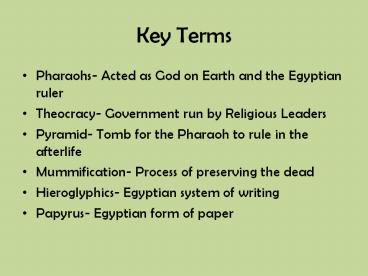Key Terms - PowerPoint PPT Presentation
1 / 18
Title:
Key Terms
Description:
Mummification- Process of preserving the dead Hieroglyphics- Egyptian system of writing Papyrus- Egyptian form of paper Warm Up Describe how Hammurabi s code ... – PowerPoint PPT presentation
Number of Views:181
Avg rating:3.0/5.0
Title: Key Terms
1
Key Terms
- Pharaohs- Acted as God on Earth and the Egyptian
ruler - Theocracy- Government run by Religious Leaders
- Pyramid- Tomb for the Pharaoh to rule in the
afterlife - Mummification- Process of preserving the dead
- Hieroglyphics- Egyptian system of writing
- Papyrus- Egyptian form of paper
2
Warm Up
- Describe how Hammurabis code influenced todays
society.
3
Ancient Egypt
4
Geography of Egypt
5
Geography of Egypt
- Settlements arose along the Nile River
- Annual flooding in July caused by rain and
melting snow in mountains - Left rich soil called silt
- Peasants would prepare fields before sun dried
out soil - Watered crops through irrigation ditches
6
Environmental Challenges
- If Nile floodwaters were lower than normal,
amount of silt to grow crops was reduced,
starving people - If Nile floodwaters were too high, water would
destroy homes and farms - Deserts natural barriers, limiting interaction
with other civilizations
7
Advanced Cities
- Narmer united lower and upper kingdoms around
3000 B.C. - Capital city of Memphis where two kingdoms met
- Traded with Mesopotamia, Kush, and Nubia
8
Complex Institutions
- Egyptian kings were considered gods
- Believed to as powerful as the gods of the
heavens - Government ruled by religious authority is called
a theocracy - Pharaohs responsible for sunrise, flooding of the
Nile, and crops growing
9
Pyramids
- Believed that the pharaohs ruled even after death
through an eternal life force called the ka - ka had needs that needed met
- Pharaohs would be placed in pyramid after death
with great luxury
10
Egyptian Religion
- Polytheistic
- Believed in an afterlife
- If you lived a pure and honest life you would
live forever in the Other World - Royal and elite Egyptian bodies preserved by
mummification, or embalming and drying of corpse
to prevent decaying
11
Specialized Workers
- Social pyramid
- Social classes could change based on marriage or
jobs - Farmers, priests, artisans, scribes, landowners,
peasants
12
Advanced Technology
- Developed calendar with 365 days
- System of numbers
- Geometry and architecture
- Medical treatments
- - heart rates
- - splints
- - treat wounds and fever
- - surgery
- Improved trade and transportation by digging
canal from Nile to Red Sea
13
Record Keeping
- Hieroglyphics
- sacred carving
- Pictures represented sounds and ideas, like the
alphabet - Common language essential for Egypts growth
- Papyrus
- River plant weaved together for paper-like
material used for writing - Faster than carving clay tablets
14
New Kingdom
15
Hyksos Rule
- The Hebrews settled in Egypt during this time
- Racially similar to the Hyksos, and welcomed to
the region - Egyptians resented the presence of these two
groups - Around 1600 B.C. warlike rulers drove out the
Hyksos
16
New Kingdom
- Hyksos were pushed into Palestine
- According to Bible, Hebrews remained in Egypt and
were enslaved until around 1500 and 1200 B.C.,
the time of the Exodus and Moses
17
Think-Pair-Share
- Most influential aspect of Ancient Egypt on
Modern Society - Fill in Graphic Organizer
18
Reflections
- Describe how Ancient Egypt dealt with their
natural, environmental problems. - Evaluate how what happened in the New Kingdom
relates to a modern day world issue. - Compare/Contrast Mesopotamia and Ancient Egypt
using the Top-Hat method.































